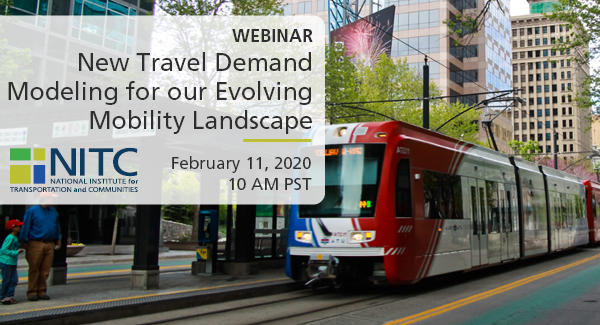Watch video
The video begins at 4:30.
The San Francisco Bay Area, like other metropolitan regions in California, is in the process of developing regional plans to reduce greenhouse gas emissions in response to state legislation that sets targets for such reduction, and prescribes that Metropolitan Planning Organizations develop Sustainable Communities Strategies that leverage changes in land use patterns in combination with transportation investments, that will meet those targets. This talk describes the land use modeling that is being used, in combination with the activity-based transportation model system at the Metropolitan Transportation Commission, to analyze alternative combinations of land use policies and transportation policies. It also will demonstrate visualization technology that has been developed to facilitate community engagement in the process
Speaker Bio: Paul Waddell is Professor and Chair of the City and Regional Planning Department at the University of California, Berkeley. He teaches and conducts research on land use and transportation modeling and planning. He designed and leads the development of the UrbanSim land use modeling platform, now being used in metropolitan planning organizations across the U.S., and in research projects throughout the world.
The video begins at 4:15.
Abstract: The California High-Speed Rail Ridership and Revenue Forecasting Model is a state-of-the-practice transportation model designed to portray what future conditions might look like in California with and without a high-speed train. The model was developed by Cambridge Systematics, Inc., and took roughly two years to complete. The resulting ridership and revenue forecasts provided, and continue to provide, sound information for planning decisions for high-speed rail in California. This presentation briefly describes the underlying model that was developed to generate the ridership and revenue forecasts along with summaries of ridership forecasts from published reports.
The video begins at 1:34.
View slides
Abstract: The combination of increasing challenges in administering household travel surveys as well as advances in global positioning systems (GPS) and geographic information systems (GIS) technologies motivated this project. It tests the feasibility of using a passive travel data collection methodology in a complex urban environment, by developing GIS algorithms to automatically detect travel modes and trip purposes. The study was conducted in New York City where the multi-dimensional challenges include urban canyon effects, an extremely dense and diverse set of land use patterns, and a complex transit network. Our study uses a multi-modal transportation network, a set of rules to achieve both complexity and flexibility for travel mode detection, and develops procedures and models for trip end clustering and trip purpose prediction. The study results are promising, reporting success rates ranging from 60% to 95%, suggesting that in the future, conventional self-reported travel surveys may be supplemented, or even replaced, by passive data collection methods.
Speaker Bio: Cynthia Chen is an associate professor in the department of civil and environmental engineering at the University of Washington. She obtained her Ph.D in civil and...
Read moreNo archived materials are available for this presentation.
PRESENTATION ARCHIVE
OVERVIEW
Conventional four-step travel demand models are used by nearly all metropolitan planning organizations (MPOs), state departments of transportation, and local planning agencies, as the basis for long-range transportation planning in the United States. A flaw of the four-step model is its relative insensitivity to the so-called D variables. The D variables are characteristics of the built environment that are known to affect travel behavior. The Ds are development density, land use diversity, street network design, destination accessibility, and distance to transit. In this seminar, we will explain how we developed a vehicle ownership model (car shedding model), an intrazonal travel model (internal capture model), and mode choice model that consider all of the D variables based on household travel surveys and built environmental data for 32, 31, and 29 regions, respectively, validates the models, and demonstrates that the models have far better predictive accuracy than Wasatch Front Regional Council (WFRC)/Mountailand Association of Governments’ (MAG) current models.
In this webinar, researchers Reid Ewing and Sadegh Sabouri will...
Read moreThe video begins at 0:52.
Abstract: This seminar concludes the eight week exploration of transportation models and decision tools with a look to the future. Oregon is known for its history of forward thinking policies around sustainable transportation, including linking land use and transportation planning at the regional level, investments in transit and non-motorized modes, and statewide legislation to reduce greenhouse gas emissions. To aid these transportation planning and policy decisions, Oregon has developed some of the most sophisticated models and analytic tools currently in use in the United States. As Oregon moves forward to address the next set of challenges - energy security, climate change, economic constraints and equity, models will need to provide new information at different spatial and temporal scales to support long range planning - 30 to 50 years out - as well as near term decisions - 1 to 5 years ahead. Beth Wemple, a Portland-based consultant with Cambridge Systematics, will share her view on Oregon's transportation future. Keith Lawton, consultant and former transportation planner at Metro, will respond by discussing the next steps for model development and application needed to support this agenda.
Speaker Bio: Keith Lawton is a transport modeling consultant and past Director of Technical services, Metro Planning Department, Portland, OR. He has been active in model...
Read moreNo archived materials are available for this presentation.

